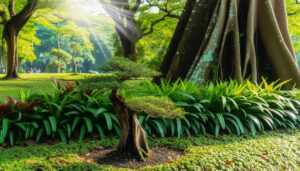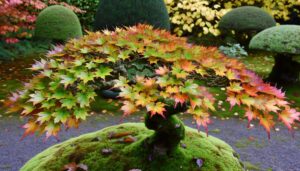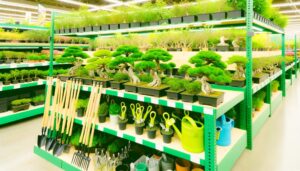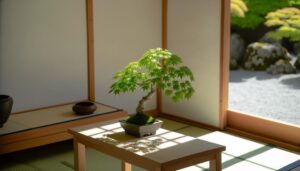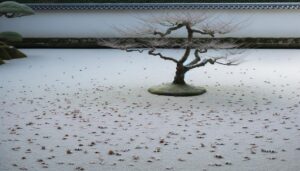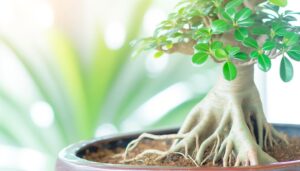7 Different Types of Indoor Bonsai Trees Perfect for Your Home
Indoor bonsai trees offer a wide variety of species, each with unique morphological and care characteristics. Ficus Bonsai (Ficus retusa and Ficus benjamina) have dense canopies and aerial roots, suitable for low light.
Chinese Elm Bonsai (Ulmus parvifolia) feature fine, serrated leaves and require well-drained soil. Jade Bonsai (Crassula ovata) present thick, fleshy leaves and require minimal watering.
Japanese Maple Bonsai (Acer palmatum) have vibrant leaf colors and need controlled humidity. Hawaiian Umbrella Bonsai (Schefflera arboricola) exhibit compound leaves and thrive with moderate light.
To explore nuanced care techniques and species-specific traits further, continue on.
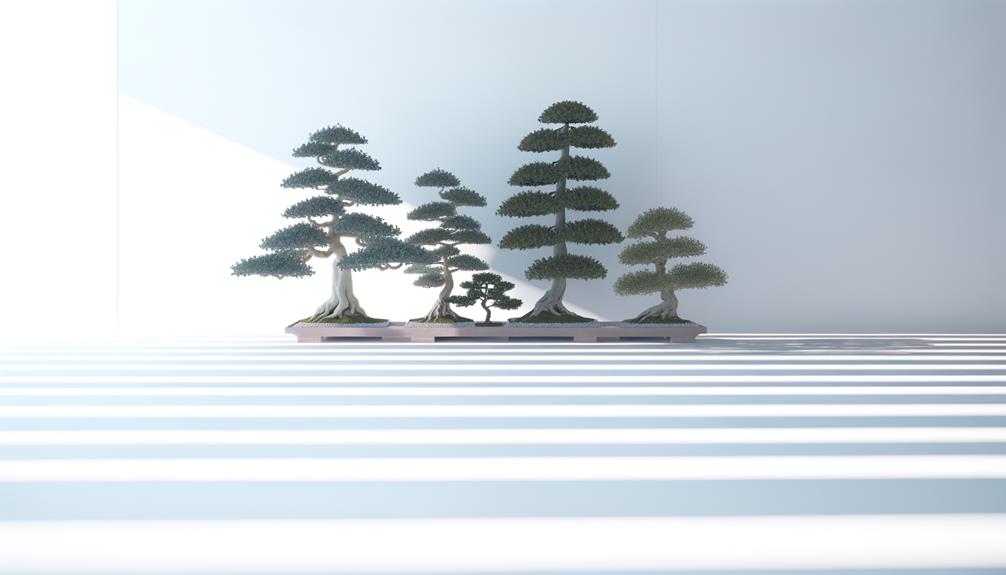
Key Takeaways
- Ficus Bonsai features aerial roots and dense canopy, suitable for low light.
- Chinese Elm Bonsai has fine serrated leaves and thrives with adequate indoor light.
- Jade Bonsai has thick, fleshy leaves and requires minimal watering.
- Japanese Maple Bonsai offers vibrant seasonal leaf colors and needs well-draining soil.
- Hawaiian Umbrella Bonsai has compound leaves and tolerates moderate indoor light.
Ficus Bonsai
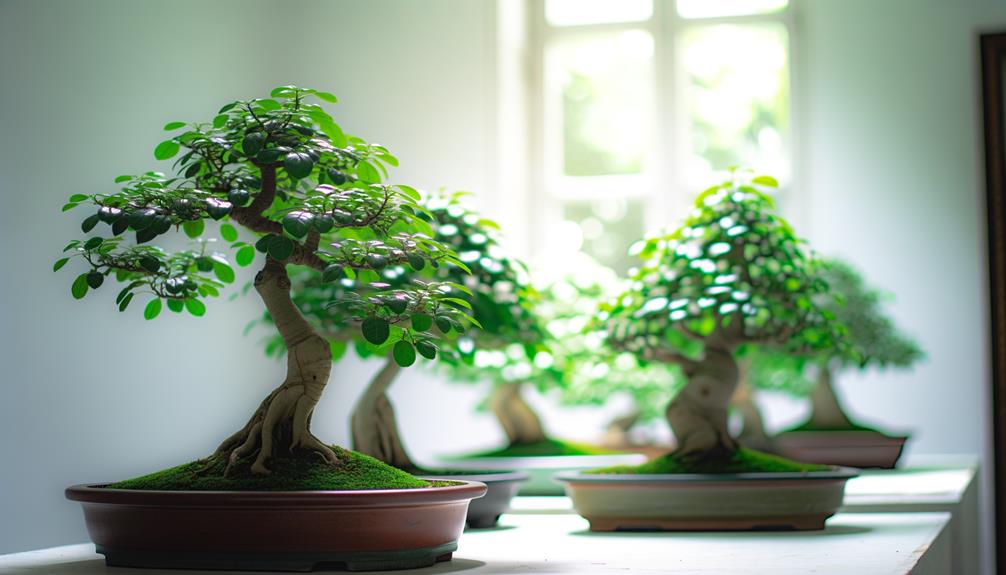
Ficus Bonsai, particularly the Ficus retusa and Ficus benjamina species, are renowned for their resilience, adaptability to indoor environments, and distinctive aerial root structures. These species exhibit coriaceous leaves, characterized by their glossy, leathery texture, which enhances their aesthetic appeal.
The morphology of Ficus Bonsai includes a dense canopy and a naturally curved trunk, making them ideal for various bonsai styles such as informal upright and banyan. Their tolerance for low light conditions and resilience against common pests underscore their suitability as indoor bonsai.
Additionally, the development of aerial roots, a hallmark of Ficus species, is facilitated by high humidity, contributing to the tree's intricate and enchanting appearance. Proper care entails regular pruning, moderate watering, and occasional fertilization.
Chinese Elm Bonsai
In contrast to the robust and adaptive Ficus species, the Chinese Elm Bonsai (Ulmus parvifolia) is celebrated for its fine, serrated leaves and elegant, fluted trunk structure, making it a quintessential choice for bonsai enthusiasts seeking a refined and graceful aesthetic.
This deciduous species, native to East Asia, thrives in well-drained soil with moderate humidity, requiring regular watering to maintain ideal health. The Chinese Elm Bonsai exhibits a high degree of adaptability to indoor conditions, though it benefits from adequate light exposure.
Pruning should be meticulously performed to maintain its intricate leaf pattern and delicate branching. Its resilience to pests and diseases further enhances its appeal, providing a reliable and visually pleasing addition to indoor bonsai collections.
Jade Bonsai
The Jade Bonsai (Crassula ovata) is distinguished by its thick, fleshy leaves and robust, woody stems, making it a popular choice for those who appreciate the succulent aesthetic in bonsai form.
Native to South Africa, this species exhibits a compact growth habit, ideal for indoor cultivation. The leaves, typically oval-shaped and glossy, store water, ensuring survival during dry periods. The bark matures to a reddish-brown hue, adding visual interest.
Crassula ovata thrives in well-draining soil and requires minimal watering, characteristic of succulents. It prefers bright, indirect sunlight to maintain its vibrant leaf coloration. Pruning is essential to shape and maintain its miniature form, encouraging dense foliage and branch development.
This hardy bonsai is relatively low-maintenance, suitable for beginners.
Japanese Maple Bonsai
The Japanese Maple Bonsai, Acer palmatum, is renowned for its striking leaf color variations that range from vibrant reds to lush greens depending on the season. Effective growth and pruning techniques are essential to maintain its characteristic shape and health, demanding precise trimming to encourage the best branch structure.
Additionally, ideal indoor conditions such as controlled humidity and indirect sunlight are critical to replicating its native environment and promoting robust development.
Leaf Color Variations
Japanese Maple Bonsai display an impressive range of leaf color variations, influenced by factors such as cultivar, seasonal changes, and environmental conditions. The Acer palmatum species, for instance, showcases a variety of hues, from vibrant reds and oranges in the autumn to lush greens in the spring and summer.
Cultivars like 'Bloodgood' and 'Deshojo' are renowned for their striking red foliage, while 'Kiyohime' offers a subtle blend of green and yellow. Environmental factors, including light exposure and temperature, further modulate these colors. Chlorophyll concentration, anthocyanin production, and carotenoid presence all contribute to this dynamic chromatic display, making Japanese Maple Bonsai a visually enthralling addition to indoor bonsai collections.
Growth and Pruning
Understanding the vibrant leaf color variations of Japanese Maple Bonsai sets the stage for mastering their growth and pruning requirements, which are pivotal for maintaining their health and aesthetic appeal. Proper pruning techniques, including apical dominance management, ensure balanced growth and best light penetration. Seasonal pruning, particularly in early spring and late autumn, is essential for controlling size and encouraging vigorous back-budding.
| Season | Pruning Activity | Desired Outcome |
|---|---|---|
| Early Spring | Structural Pruning | Shape definition, branch strength |
| Late Spring | Pinching New Growth | Density increase, compact foliage |
| Summer | Minor Touch-ups | Aesthetic refinement |
| Late Autumn | Major Pruning | Size control, health maintenance |
This structured approach not only enhances the tree's visual allure but also fortifies its overall physiological resilience.
Ideal Indoor Conditions
Securing ideal indoor conditions for Japanese Maple Bonsai involves careful attention to light, humidity, temperature, and soil requirements to nurture a thriving environment.
Japanese Maple Bonsai requires bright, indirect light to aid in photosynthesis without causing leaf scorch.
Maintaining ambient humidity levels between 40-60% is vital, as dry air can lead to desiccation of foliage.
Best temperature ranges from 15-25°C to replicate its natural habitat, avoiding extreme fluctuations.
The soil should be well-draining yet retain ample moisture; a mixture of akadama, pumice, and lava rock is suggested for its aeration properties.
Regular monitoring and adjustments are necessary to adapt to seasonal changes, ensuring the bonsai remains strong and resilient.
This all-encompassing approach guarantees the Japanese Maple Bonsai thrives indoors.
Hawaiian Umbrella Bonsai
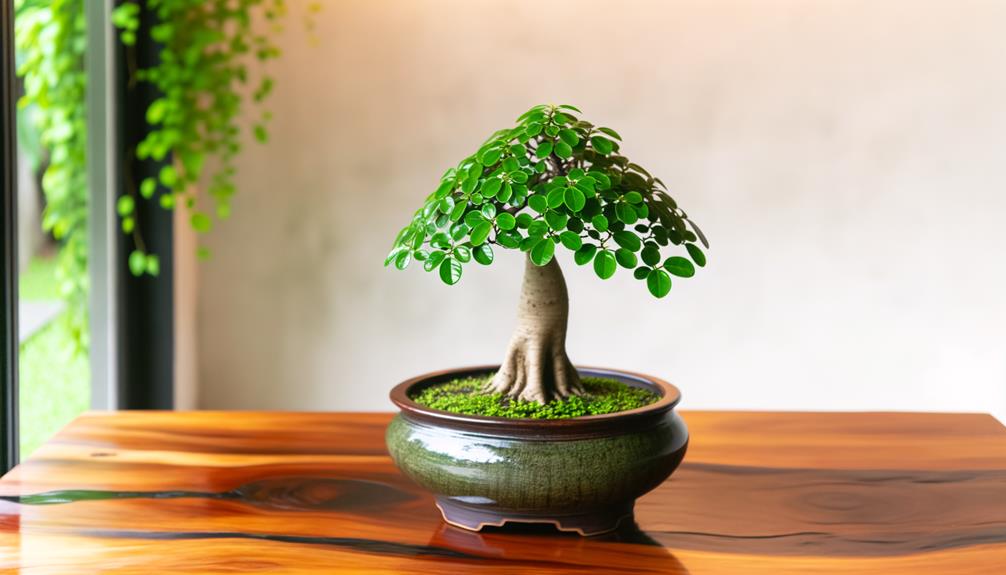
The Hawaiian Umbrella Bonsai, scientifically recognized as Schefflera arboricola, is a popular choice for indoor cultivation due to its resilience and distinctive, umbrella-like foliage. This species is known for its compound leaves, which consist of multiple leaflets radiating from a central point, creating a unique canopy effect. It thrives in a well-draining soil mix and requires moderate watering to maintain peak health.
| Characteristic | Description |
|---|---|
| Botanical Name | Schefflera arboricola |
| Light Requirements | Moderate to bright indirect light |
| Watering Frequency | Moderate, allowing soil to dry |
| Soil Type | Well-draining bonsai mix |
| Temperature Range | 60-75°F (15-24°C) |
Proper care promotes strong growth, making it a suitable choice for enthusiasts seeking an aesthetically pleasing and manageable bonsai tree.
Serissa Bonsai
Serissa Bonsai, also known as Serissa Japonica or Snow Rose, requires meticulous care and maintenance to thrive indoors. This species is sensitive to environmental changes, necessitating consistent watering, high humidity, and well-draining soil to prevent root rot.
Additionally, Serissa Bonsai exhibits pronounced seasonal changes, including blooming periods and leaf drop, which must be managed through precise adjustments in light exposure and temperature regulation.
Care and Maintenance
To maintain peak health and aesthetic appeal, proper care and maintenance of Serissa bonsai trees require close attention to their unique environmental and physiological needs. Best growth is achieved by ensuring consistent humidity levels, as these trees are sensitive to dry air.
Positioning the Serissa in bright, indirect light is ideal; direct sunlight can cause leaf scorch. Watering should be meticulously managed; soil must remain consistently moist but not waterlogged. Employing a well-draining substrate is essential to prevent root rot.
Pruning should be performed regularly to maintain shape and encourage branching, using sterilized tools to avoid infections. Finally, monthly fertilization during the growing season supports nutrient requirements and promotes vigorous growth, employing a balanced, water-soluble fertilizer.
Seasonal Changes
Understanding how seasonal changes impact Serissa bonsai trees is essential for maximizing their care regimen throughout the year. Serissa, commonly known as 'Tree of a Thousand Stars,' is sensitive to temperature fluctuations and photoperiod changes.
In winter, reduced daylight and cooler temperatures require maintaining a stable indoor environment with temperatures above 10°C to prevent dormancy stress. Adequate humidity levels, around 50-60%, are pivotal to counteract indoor heating's drying effects.
During spring and summer, Serissa thrives in temperatures between 18-24°C, benefiting from increased light exposure. Seasonal pruning should be conducted post-bloom in late spring, while fertilization regimens should be adjusted to support active growth phases. Properly synchronizing care practices with seasonal dynamics ensures robust health and best aesthetic development.
Juniper Bonsai
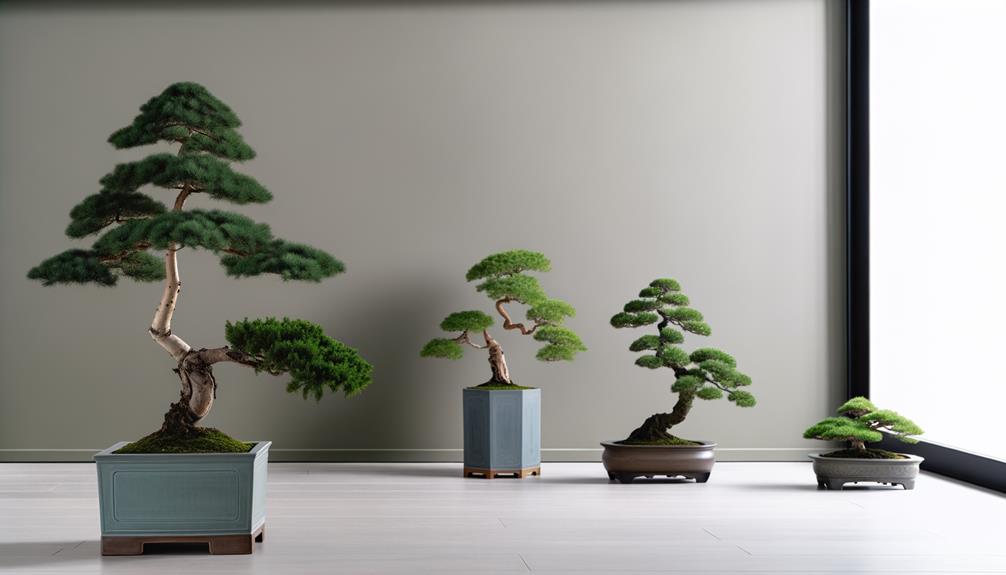
Juniper Bonsai, known scientifically as Juniperus, are popular for their hardy nature and the aesthetic appeal of their needle-like foliage, making them a favored choice among bonsai enthusiasts. These coniferous trees exhibit a remarkable adaptability to various conditions, thriving in well-drained soil with moderate watering.
The foliage, comprising scale-like or needle-like leaves, contributes to the tree's robust appearance. Pruning techniques such as pinching and wiring are essential to maintain the desired shape and promote dense growth. Additionally, junipers benefit from exposure to bright, indirect sunlight, which fosters photosynthesis and healthy development.
Despite their resilience, they require protection from extreme indoor conditions, such as low humidity and poor air circulation, to prevent stress and pest infestations.
Carmona Bonsai
Carmona Bonsai, scientifically identified as Ehretia microphylla, are distinguished by their shiny, dark green leaves and petite white flowers, making them an aesthetically pleasing option for indoor bonsai cultivation. These trees flourish in well-draining soil and need regular watering to maintain ideal moisture levels. Additionally, Carmona Bonsai prefer bright, indirect sunlight and can be sensitive to temperature fluctuations.
| Aspect | Details |
|---|---|
| Botanical Name | Ehretia microphylla |
| Leaf Characteristics | Shiny, dark green |
| Flowering | Petite white flowers |
| Light Requirements | Bright, indirect sunlight |
Proper trimming and wiring techniques are essential for shaping. Regular feeding with balanced fertilizers promotes healthy growth. Understanding these requirements guarantees the successful cultivation of Carmona Bonsai, making them a fulfilling addition to indoor greenery.
Conclusion
The diverse array of indoor bonsai trees, from the resilient Ficus to the delicate Serissa, mirrors the intricate balance found in nature.
The Japanese Maple, for instance, can be likened to an artist's canvas, where each leaf's transformation through the seasons symbolizes life's perpetual change.
Cultivating these miniature trees is not merely a horticultural endeavor but a lifelong practice in patience and precision, echoing the meticulous craftsmanship required in scientific research.
This pursuit ultimately fosters a deeper connection to the natural world.

